
- Private
Transport
-

- A car at the petrol pumps (showing the sign of Cleveland
Petrol)
- outside the shop of William J Henry about 1920
In the 1920s and 30s cars were still few and
far between but just following the Second World War, the use of private
cars became more popular, and by the end of the century over half of households
had two cars. This probably had one of the biggest effects on the village,
over the last 50 years. The effects of this were closure of shops with the
increase in traffic turning some parts of the village into dormitory areas
with no local services.
 |
School Crossing Patrols go back to the 1950s for Wyke Primary School
at the junction of Westwood Lane, Guildford Road (A323) and School
Lane (Speed bumps were added to School Lane in the 2000s).
A Speed Limit of 40 MPH alone Guildford Road (A323)
from School Lane to the Anchor came in to force in the mid 1960s also this
was in Westwood Lane up to Christmaspie. This was reduced to 30 MPH
and extended in 2006 and a 40 MPH was added to the
Pirbright Road (A324). |
 |
 |
- Yellow Lines were added to the Cross Roads at the War Memorial in late
1980's covering the Post Office, Normandy Butchers and Normandy Stores,
on the opposite side of Hunts Hill Road to the War Memorial a car park
had been added some years earlier
|
 |
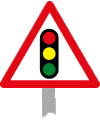 |
Traffic lights were added to the junction between Pirbright Road (A324)
and the Guildford Road (A323) at Elm Hill in the late 1990's following
and number of accidents at this busy junction. |
 |
- Garages
- In the 1950's, Normandy had three garages
(Anchor Garage, Normandy Garage and Westwood Lane Garage), but by the end
of the century they had all stopped selling petrol.
Anchor
Garage
In 1923 it was taken over by Albert Henry Wiltshire and son. When son William
Wiltshire built the house called Lynthorne and moved across the road around
1930, W L Yorke started the garage under the name of Cleygate Garage. It
had one hand-operated 'wind-up' petrol pump.
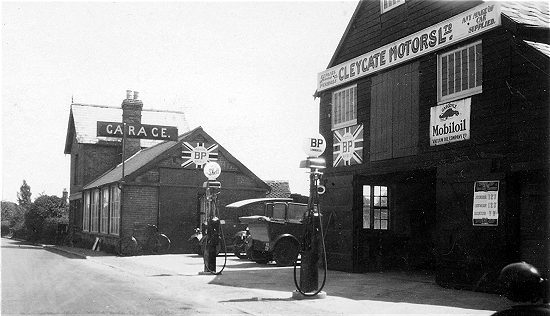
- Cleygate Garage c1932
In 1935 C W (Paddy) Johnston, the former TT motorcycle champion, took
it over and was proprietor for several years under the name of the Open
Road Garage.
In the 1950s, 'Monkey' Marsden ran the garage.
The nickname derives not from an insult but from the large cage of monkeys
kept on the garage forecourt by Mr Marsden. These monkeys were constantly
escaping and villagers can recall them climbing on cars and banging on the
roofs. One of them even managed to jump on a motorcyclist's back and remove
the astonished man's crash helmet before he knew what was happening! The
next proprietors were Frederick Bayliss and Reginald Dare who ran it under
the name of Anchor Garage Ltd. Also at this time the garage had a transport
Café (Red Arrow Snack Bar) next to it on the Guilford side
that was still open in 1970. It was sold again in about 1979 and it became
Wyke Hurst at Normandy.

- Wyke Hurst at Normandy 1992
Normandy
Garage
Thomas James started Normandy Garage in the late 1920s, who by 1936 was
offering "any make of car, lorry, electrical or radio parts (telephone
Normandy 13)". He also mended mowers and bicycles. According to
local residents, filling your car with petrol in those days was a very leisurely
affair. Tommy would stroll out of the workshop and, after a chat, would
labouriously pump the petrol from one of his 'side-to-side' type pumps.
The Richards family came to Normandy Garage
in 1966 and became outright owners in 1976. John concentrated on building
up the service side of the operation while Joan manned the petrol pumps.
In 1982 the trend towards vehicle sales culminated in Normandy Garage becoming
one of the first UK Hyundai franchises. Their success led to the complete
remodelling of the site in the winter of 1997/98 with an impressive modern
showroom.
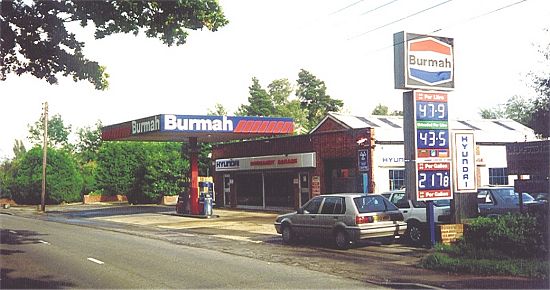
- Normandy Garage 1992
Westwood
Lane Garage
The third garage in Normandy, in Westwood Lane, was started in the early
1930s by Richard (Dick) James, Tommy James' brother. At first the garage
was just a shed where Dick did repairs, sold paraffin, etc. He started the
haulage business with just one lorry. Nearby Fred Nunn, who made breezeblocks
also sold petrol from his pump.
After the war Dick had the two fields beside
the garage full of army-surplus lorries which he was repairing and selling
for the 'groundnut scheme' in West Africa. In the late 1950s
he sold the garage to Mr Ashe who modernised it. By 1965 it was Normandy
Engineering Limited, advertising in an official parish guide: - "Petrol,
repairs, service, plant hire, site clearing and earth moving. Cut prices
and Green Shield stamps". Since about 1971 it has been All Recovery,
a breakdown recovery service owned and run by Brian Mayhead.
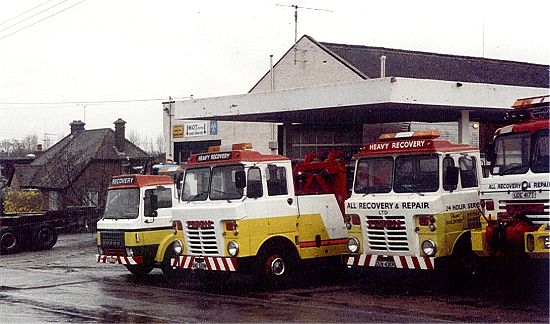
- Westwood Lane Garage (All Recovery) 1992
Normandy
Scrap Yard (Willey Green)
This property was originally part of Chapel Farm. The Bayliss family moved
there in 1936 from West End, Woking and were timber merchants. By 1938 William
Bayliss was dealing in second-hand cars and during the war they broke up
cars to provide much-needed metal. This was the origin of the scrap-yard.
In 1965 Normandy Auto Salvage started trading and in the early 1980s it
was run by A G Bayliss and managed by John Norgate with a staff of six,
offering "a vast range of spare parts".
Normandy
Motorcycles
Normandy Motorcycle Company was established in about 1959 by brothers Brian
and Mike Garbutt in what had been Mrs Carpenter's bakery and general stores.
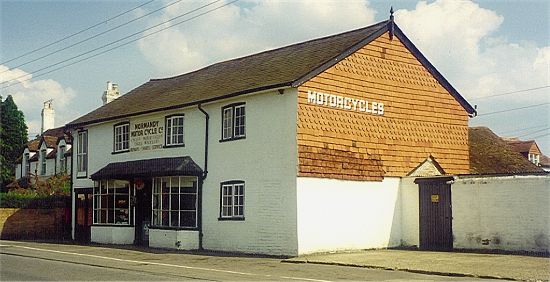
- Normandy Motorcycle 1989
-
- Driving in Normandy - The Driving
Test
- The RAC was founded in 1897 as the Royal Automobile
Club and a group of motoring enthusiasts form the Automobile Association
(AA) on 29 June 1905 at the Trocadero restaurant in London's West End,
from the late 1920's a number of books on "how to drive a car"
were published and in 1930 the Minister of Transport, Herbert Morrison,
proposed the passing of a Bill, which became the Road Traffic Act 1930
and came in to effect, April 1931, the first edition of the Highway Code
was also published in this year.
-
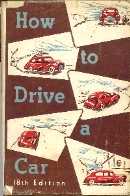  Here are two covers from a book
published in association with "The Motor" Here are two covers from a book
published in association with "The Motor"
- (a magazine of the time)
-
- (Left) "How to Drive a
Car" 14th Edition published
about 1935 at a cost of 2/6
- (140 page Hardback)
- (Right) "How to Drive a
Car" 18th Edition published
1950 at a cost of 5/-
- (160 page Hardback)
|
- The Driving Licence
- Here are the documents you would have received
if applying for a driver's licence in 1947.
- ... ...
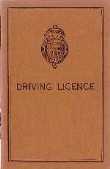 .
..... . ..... .
..... . ..... 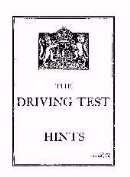 .......... .......... 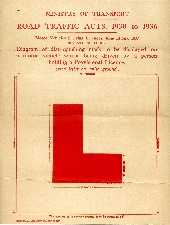
| Driving Licence |
Driving Test Hints |
'L' Plate, Regulations |
-
| 
Application for Driving Test
Click on photos for more information |
- You would have
also needed to get a copy of the Highway Code from a local newsagent at
the cost of 1d, the one in use at this time was the third edition from
1946, but remember at this time there were still many horse and carts on
the road making deliveries and police officers still carried out point
duty.
- The Highway Codes
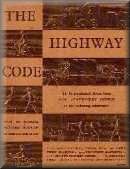
- 1946
- cost 1d
|
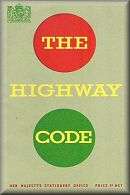
- 1954
- cost 1d
|
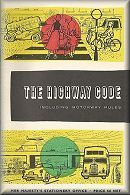
- 1959
- cost 6d
|
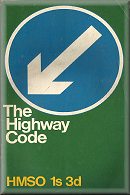
- 1968
- cost 1/3
|
- Click on book to see an enlargement of the full book
|
 Ministry of Transport - Vehicle Testing Ministry of Transport - Vehicle Testing
- Following the second world war and into the 1950s most people purchased
second hand cars and light vans, many of which were originally manufactured
pre war and were not in 'tip top' condition. As a result there were numerous
vehicles being used on the road that were potentially dangerous. In particular
they often had problems with brakes, lights or steering. As a result of
this, in 1960 the then Ministry of Transport under the direction of the
Minister of Transport Mr Ernest Marples decided that all vehicles over
ten years old should have their brakes, lights and steering checked every
year. This became known as the "Ten year Test", or alternatively
the Ministry Of Transport Test - which became shortened to 'MOT'. The Testable
age was progressively reduced to 3 years by April 1967, while some "limited
use" and agricultural vehicles are exempt from test altogether.
In Normandy during the 1960s the Anchor Garage and Normandy Garage where
listed as test stations for cars and light vans and Normandy Motorcycles
provided this service for motorcycles, scooters, motorcycle combinations
and Three wheeled vehicles. |
| 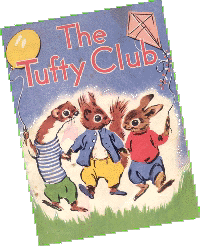 Road Safety Road Safety
Normandy with its two main roads had problems with road safety particularly
with children, but in the 1950s and 60s, through very simple films, books
and stories by "RoSPA" (Royal Society for the Prevention of
Accidents), Tufty persuaded pre-school children that the road could
be a dangerous place. This was done through the medium of burst footballs
and dropped ice-creams, rather than something which young eyes might find
too upsetting, such as squashed squirrels.
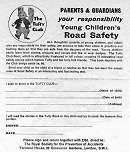 Tufty (full name Tufty Fluffytail) had his origins in 1953, created
by the late Elsie Miles. In 1961, the Tufty Club was set up as a network
of local groups - which at its peak had nearly 25,000 branches throughout
the country. Parents would join the Tufty Club on their children's behalf,
and children would proudly wear badges showing that they were members. Tufty (full name Tufty Fluffytail) had his origins in 1953, created
by the late Elsie Miles. In 1961, the Tufty Club was set up as a network
of local groups - which at its peak had nearly 25,000 branches throughout
the country. Parents would join the Tufty Club on their children's behalf,
and children would proudly wear badges showing that they were members.
Click on form to see an enlargement |
- Downloads
 Map
of the Roads through the Parish of Normandy (607kb) (JPG
format) Map
of the Roads through the Parish of Normandy (607kb) (JPG
format)
 Driving
Test Hints (1946) (111kb) (PDF format) Driving
Test Hints (1946) (111kb) (PDF format)
 'L'
Plate, Regulations (1936) (144kb) (JPG format) 'L'
Plate, Regulations (1936) (144kb) (JPG format)
 Application
for Driving Test (1946) (174kb) (PDF format) Application
for Driving Test (1946) (174kb) (PDF format)
 The
Tufty Club - Application Form (1961) (167kb) (JPG format) The
Tufty Club - Application Form (1961) (167kb) (JPG format)
-
- Wikipedia links
- Road Traffic Act 1930
- Herbert
Morrison (Minister of Transport, 1930)
- Ernest
Marples (Minister of Transport, 1959-64)
- The
Highway Code
- Royal Society for the Prevention of Accidents (RoSPA)
- Tufty
Club

 Return to Road Transport Page Return to Road Transport Page
 Back to Index Back to Index
-
- © Copyright by Normandy
Historians All Rights Reserved.
|













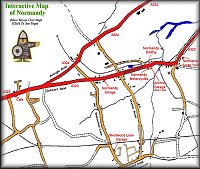

 Here are two covers from a book
published in association with "The Motor"
Here are two covers from a book
published in association with "The Motor" 







 Ministry of Transport - Vehicle Testing
Ministry of Transport - Vehicle Testing
 Road Safety
Road Safety